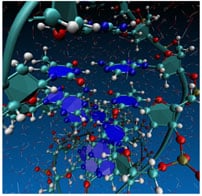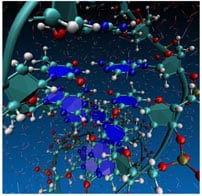
Historically, proposals for molecular nanotechnology by K. Eric Drexler and others, usually referred to these days as high-throughput atomically precise manufacturing, have been based upon physical law. The very earliest proposals (1981, 1986) argued that biological molecular machine systems provide an existence proof that artificial molecular machine systems could work together to built large atomically precise systems. However, serious study of what is possible, beginning with the book Nanosystems in 1992 and continuing with the 2005 animated short film “Productive Nanosystems: from Molecules to Superproducts”, described here and on Drexler’s web site, have been based on what physical law says is possible. Such studies have relied heavily on computational chemistry based on first-principles calculations. They have been limited by the fact that, even with substantial increases in available computer power over the past decade, it is difficult to study systems of more than a few hundred atoms. Foresight President Paul Melnyk sends this news that limitation may be disappearing soon. A hat tip to Nanowerk for reprinting this news from the London Centre for Nanotechnology “Large-scale simulations of atom dynamics“:
Researchers develop a new method for simulating previously unstudied complex matter
An international research team has developed a highly efficient novel method for simulating the dynamics of very large systems potentially containing millions of atoms, up to 1000 times more than current conventional methods. This advance will open up a range of possibilities for accurately studying complex matter, for example biomolecules in solution, and gaining a previously unattainable understanding of processes such as electron, water or ion transport or chemical reactions.
Until now, the size of the systems modelled with established first-principles methods has generally been limited, due to time and complexity, to only a few hundred atoms. For the first time, this new method provides the means of performing atomic and electronic structure simulations on much larger systems, potentially uncovering a range of new and unknown properties.
Matter is composed of atoms, and its physical characteristics are determined by the complex interactions between atoms and electrons. Theoreticians use quantum mechanics to calculate the forces between atoms, and the behaviour of electrons in materials. Specifically, first-principles simulations are based on quantum mechanics, and are a powerful technique widely used to uncover diverse properties of matter and materials at the atomic scale.
The research team, led by TYC member David Bowler, UCL and NIMS MANA and Tsuyoshi Miyazaki at NIMS, used high performance computing to introduce a new technique, where the time required for the calculations increases linearly with the number of atoms, to perform first-principles dynamical simulations of systems comprising more than 30,000 atoms, 100 times larger than is usual with conventional methods. The technique has further been used to calculate properties of over 2 million atoms.
This new method will be an invaluable tool for those using predictive computational modelling and, as most simulations are stuck below 1,000 atoms, it will open the doors to studying completely new areas of physics.
The research was published late last year in the Journal of Chemical Theory and Computation [abstract]. The authors have made a full text preprint available at arxiv.org “Stable and Efficient Linear Scaling First-Principles Molecular Dynamics for 10,000+ atoms” (PDF). If this approach, in which the computational cost of a simulation grows linearly with the number of atoms instead of as the cube of the number of atoms, turns out to be generally useful, then expanding the number of atoms that can be handled in a first-principles molecular dynamics calculation from a few hundred to two million would be of great use to many efforts, including the development of atomically precise manufacturing.
—James Lewis, PhD
